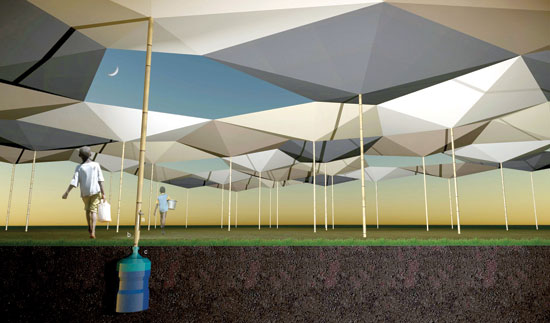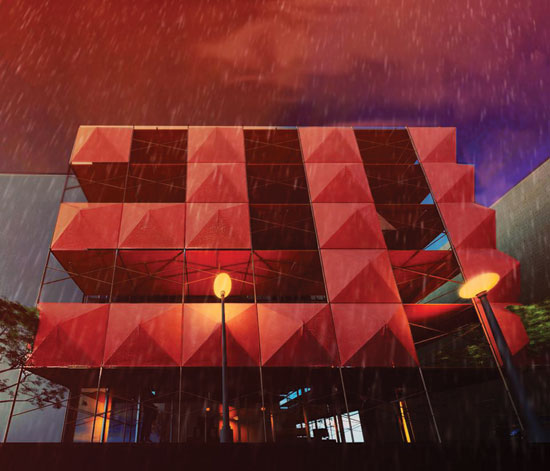The Future of Shade
Fabric components in sustainable architecture design
![]() Continuing Education
Continuing Education
Use the following learning objectives to focus your study while reading this month’s Continuing Education article.
Learning Objectives - After reading this article, you will be able to:
- Discuss innovations and futuristic objectives for using shade structures constructed with fabric in commercial architecture.
- Explain how shade structures made of fabric can add both appealing design and functionality to building structures.
- Define the benefits of shade structures for personal health and UV protection.
- Discuss how the use of textiles in shade structures can positively impact thermal performance and energy efficiency.
- List LEED credits to which awnings and solar shades can contribute directly.
Shade is arguably one of the vital elements in modern life, though not something that typically takes center stage in the design dialogue. Until recently, fabric shade structures were an appendage to a building, an afterthought, an accessory.
Increasingly though, shade structures begin the design conversation. This is particularly so in commercial buildings, those in sunny climates, those which will inhabit a warming planet (this one), and by architects looking for new ways to create built environments in harmony with nature's forces. The future includes a conscious intention toward shade structures.
“I think architects are interested in the future of shade because it's a natural phenomenon that we can control. It's predictable,” says Marc Kushner, a practicing architect with Hollwich Kushner (HWKN) in Manhattan and CEO of Architizer. “And in a world where a lot of nature is becoming increasingly unpredictable, the sun follows the same path year after year, day after day. And we can respond to that and start to sculpt that to create the right environments.”
What Is the Future of Shade?
In a globally announced design competition called the “Future of Shade,” architects were asked to submit innovative ideas for using fabric in shade designs. Of the more than 140 entries submitted on the Architizer platform, three judges selected three standout concepts and a number of notable designs. The winners all reflected what the judges saw as the intersection between stylish design and benefits for humankind.
Fred Bernstein, an architecture writer and critic and one of the judges, says of a project: “It's much more than just beauty. It's beautiful in the way it looks, but it's also beautiful in the way it behaves, in the way it helps people's lives.”

Photo courtesy of Sunbrella
“Twisty,” an innovative and flexible shading system, won a 2013 competition on the future of shade. An installation of Twisty was brought to life at The James Royal Palm in Miami Beach.
Submissions included shade concepts from small shade structures for bus stops and bridges, to massive installations for train stations and beaches, and designs with multiple purposes: shade and water collection, art installation, and protection from the elements.

Photo courtesy of Sunbrella
The three judges for a recent design competition on the future of shade were, from left, Marc Kushner, practicing architect and CEO of Architizer; Scott Campbell, president of Rainier Industries, and architectural writer and critic Fred Bernstein.
“I love seeing architects and designers connect with a topic like shade and push themselves to come up with new designs and solutions for shade,” says Kushner.
For Kushner, the most important criteria was innovation: “How can we take this topic of protection from the sun and explore it, expand it and see what the potential of the built environment in shade is? I was also looking at other topics as we were judging. I was interested in how the softness of the materials could be exploited by architects and designers.”
The third judge for the competition was Scott Campbell, president of Rainier Industries, whose experience leaned toward the practicality of manufacturing potential winning entries.
“The winning entries all have an element of simplicity,” Campbell notes. “Even though they may have looked complex, they were easy to fabricate, or to be fabricated. Some of them required a little more engineering and weren't fully fleshed out, but all of them had a core simplicity that made them eminently practical.”
And for Bernstein as well, innovation was the key winning element.
“I was looking for something much more architectural, something that used shading fabric in a novel way, in a way we hadn't seen before, in a way that curves, maybe twists, that really creates architecture, that enhances some of the trends I'm seeing in contemporary architecture, but using fabric rather than hard materials.”
How the World of Shade Structures Is Changing
As these and other entries into the Future of Shade competition demonstrate, shade is not just an afterthought, but is increasingly informing architecture.
“Fabric lets architects push the envelope on shade design because it takes a bunch of things out of the equation,” Kushner explains. “It's cost-effective. It's highly durable. It comes in a million colors. So, those are all things that we worry about. Now that that's out of the way, we can concentrate on the good, fun stuff, which is how we can start to manipulate it and shape it to do things that we couldn't normally do with solid and rigid architecture.”
Bernstein agrees: “Architecture provides shade, but it generally provides shade using hard or rigid materials. Using soft materials, you can provide shade in ways that are flexible so that everyone can have the amount of shade they want. Shade can be personalized or customized.”
The Design Benefits of Using a Pliable Material like Fabric
For architects, and particularly the younger breed of designers born into a world changing at perhaps the fastest pace ever, switching from a strict reliance on traditional building materials to a fabric-infused language should be smooth.
“We usually use hard stuff, like stone and wood,” Kushner says. “So, with fabric, you can crinkle it; you can fold it; you can crease it. You can do fun things with it that you can't do with the other stuff we usually use.”
“There's something so incredibly beautiful and intriguing and compelling about translucent materials,” Bernstein adds.
Design and Function with Shade Structures
In 2013, the inaugural Future of Shade competition brought in dozens of innovative ideas from architects inspired by the shading fabric itself.
Bernstein explains the appeal: “Fabric is light, so you can certainly do things with fabric that you can't do with other materials.”
As these design competitions affirm, shade and shading fabrics excite and inspire architects' imaginations all over the world.
In order to appreciate the future of shade and position oneself on the leading edge of this movement, it helps to review the past, the long history of using fabrics as architectural add-ons, and how the practice has evolved in the past century.
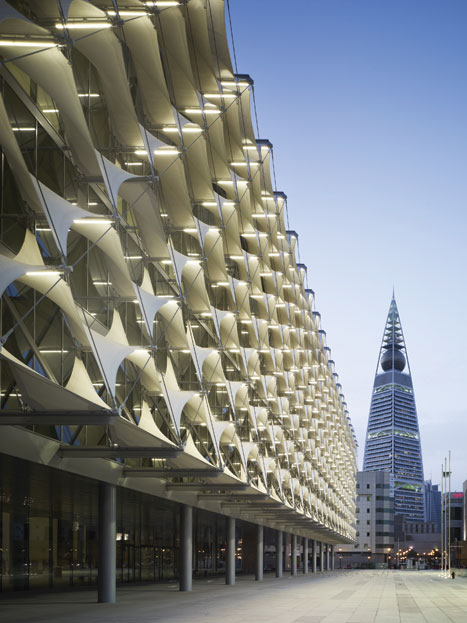
Photo © Gerber Architekten: Christian Richters
In Riyadh, Saudi Arabia, a glass-enclosed expansion to the King Fahd National Library was complemented by a woven glass-fiber membrane made of 1,000 twisted square awnings that block 93 percent of the incoming sunlight.
The Evolution of Shading Fabrics
Prior to the 1960s, most awnings and shading fabrics were made of cotton canvas, which the sun broke down quickly. In 1961, the owners of one of the oldest, most respected fabric brands decided to change the nature of shading materials the company had been making since the 1880s. They replaced cotton with acrylic fibers and pre-extrusion pigments and offered an unheard-of warranty of five years. They were dubbed “performance fabrics.”
In the 1970s, performance fabrics got the attention of boaters, and the outdoor furnishings industry exploded with these new, long-lasting yet pliable fabrics. In 1988, BMW became the first car brand to adopt this company's fabrics for its convertible models.

Photo courtesy of Sunbrella
The use of shading fabric as a branding strategy spans history.
By the early 2000s, as the green building movement gained momentum with the U.S. Green Building Council's LEED rating program, more attention was paid to the sustainable nature of performance fabrics. As high-performing shade fabrics last longer, people use less fabric and thus generate less waste as compared to other fabrics that might fade, lose strength, or give in to mildew and atmospheric chemicals. In fact, some fabrics can be recycled through manufacturer recycling programs, reducing impact on landfills. This is in addition to the energy benefits of building shading that will be discussed later in the course.
The cleanability of outdoor shading fabrics is among the latest topics to interest industry and end users alike. Because of the sturdy makeup of high-performance shading fabrics, they can be cleaned with a variety of common cleaning products, such as dishwashing liquid, vinegar, ammonia, acetone, paint remover, turpentine, and even bleach. (See manufacturer's recommendations for specific amounts and mixtures.) Of course, brushing off dirt and dust at regular intervals is a good deterrent to staining. While advanced shading fabrics do not promote mildew growth, mildew may grow on dirt and other foreign substances that are not removed from the fabric. Some manufacturers recommend specific spray-on fabric-guard products to strengthen or restore a fabric's water repellency.
Signage and Branding with Fabrics
As the use of shading fabric continues its trajectory in modern architecture, its use as a business branding strategy spans the decades. Historically, a print canvas canopy over a cigar shop or beauty parlor signaled the establishment's presence to passersby.
While that design practice continues today, modern corporate branding with fabric is often spectacular, with enormous printed banners moving in the breeze. They are a signal to passersby and even passing aircraft that business or cultural events are happening there. The colors of the shading fabric convey their own branding message, tying into the corporate, company, educational, or non-profit organization's identity.
Expanding Space
Shading strategies in corporate, cultural, and residential settings create copious amounts of added space for meetings, gatherings, meals, and leisure. While the cost of walls and a roof could be prohibitive, and most likely exceeding a particular lot's allowable square footage of structure, the addition of shaded “rooms” becomes a possible way to expand the amount of usable space. Fabric enclosures in commercial spaces such as restaurants can help boost profits by increasing the amount of outdoor seating available year round.
Although the early history of awnings and shade structures was driven by many factors—business branding, shelter from rain and sun, expanding space—only recently has sun protection taken on dire significance concerning skin cancer prevention. That and other less deadly but equally impactful consequences of the sun/shade paradigm will be discussed next.
Shade Structures for Personal Health and UV Protection
Why is shade important to humanity?
In iconic portrayals of early humans struggling to survive harsh environments, shade of some sort will likely be depicted: from caves to animal-skin tents to families on the savanna huddled beneath the shade of a tree. Protection from the sun has always been important to humanity, but never so much as it is in modern times, with holes in the ozone layer and the unprecedented speed at which our planet is warming. Whereas natural climate change occurs gradually, giving organisms the opportunity to evolve their own protections, the speed of this man-induced climate change requires man-made protections.
There are, of course, positive and negative aspects of sunlight. Photosynthesis, which transforms minerals and water into plant matter, relies on sunlight, and we rely on the food produced by sunlight. The very fuels we dig increasingly deeper to harvest, originated from microscopic plants and animals absorbing energy from the sun, which was stored as carbon molecules and later as oil or gas. In some countries, the sun is increasingly harnessed to create solar power.
Even for humans, sunlight is a powerful mood boost, as is attested by the increase of SAD (seasonal affective disorder) sufferers during wintertime or in areas where days are shortened. It gives us light during daytime hours, which makes life easier and more energy efficient. It even prompts the human body to produce vitamins, especially D.
Ideally, we don't want sunlight to be totally “on” or “off,” and that is where UV-resistant shading fabric (as well as shade itself) comes into play.
Rising skin cancer rates are one of the biggest negatives for sun exposure. According to the Skin Cancer Foundation:
• Skin cancer is the most common form of cancer in the United States; more than 3.5 million skin cancers in over two million people are diagnosed annually.
• Each year there are more new cases of skin cancer than the combined incidence of cancers of the breast, prostate, lung, and colon.
• Treatment of nonmelanoma skin cancers increased by nearly 77 percent between 1992 and 2006.
• Over the past three decades, more people have had skin cancer than all other cancers combined.
• One in five Americans will develop skin cancer in the course of a lifetime1.
“Almost all of the conditions were caused by unnecessary ultraviolet (UV) radiation exposure,” stated Howard K. Koh of the U.S. Department of Health and Human Services. “As a nation, we can all do more to address skin cancer as a serious public health challenge.”2
The Acting U.S. Surgeon General, Dr. Boris D. Lushniak, a dermatologist, recently released a “Call to Action to Prevent Skin Cancer.”3 In the report, he repeatedly includes seeking shade as a known method of preventing skin cancer. This is particularly needed in areas where children play, including pool environments. Providing shade in pool environments is encouraged by “Pool Cool Program,” a research program from the University of Pennsylvania.4
And the Skin Cancer Foundation recommends fabric awning as well as marine and upholstery fabrics in shading products to help in the prevention of sun-induced damage to the skin as part of a complete sun protection regimen, including regular use of sunscreen.
As the Pool Cool Program points out, changing behaviors that cause us to seek shade are beneficial for human health. Increases in shading strategies and structures are also good for the health of the planet and the comfort levels of humans in buildings.
Textiles in Shade Structures for Thermal Performance and Energy Efficiency
Many factors drive the need for shade structures.
Demographics show that more and more people are living in sunny and hot locations. In the United States, according to census data, population growth in southern and western states, which is led by Florida, Texas, and California, accounted for more than 80 percent of new residents in the past few years.
“That requires a lot of air conditioning,” notes Bernstein.
In these southern states and others, unfettered daylight entering a building brings with it several serious challenges:
• Glare, which causes stress and strain on the occupants
• Solar heat gain, which drives up energy use
• Ever changing nature, which is difficult for solid structures to ameliorate
• UV rays, which cause health problems and fade furnishings
On the upside, controlled natural light entering a building potentially saves energy and operating costs.
According to the U.S. Dept. of Energy, buildings account for about 40 percent of total U.S. energy consumption (costing $350 billion per year) and greenhouse emissions.5 Commercial buildings use 18 percent of all energy, and lighting accounts for 26 percent of that, using the same amount of energy as heating and cooling combined.
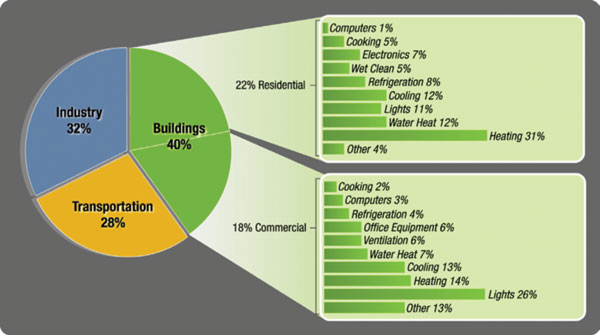
Image courtesy of U.S. Department of Energy
Decreasing the need for artificial lighting and unwanted solar gain, while increasing the opportunity for wanted solar gain, are made possible by exterior shading strategies.
A number of high-profile projects use flexible, movable exterior shading strategies to achieve these goals—to counteract the deleterious effects of sunlight and to harvest that sunlight as conditions indicate. These are known as “dynamic facades.”
Well-known dynamic facade projects are located in Chicago (Loyola University), Singapore (Gardens by the Bay), Tokyo (Sony), and other places.
Exterior shading devices will likely continue their upward trajectory and certainly appeal to architects' drive to combine form and function, particularly high-performing, energy-efficient functionality.
This is clear to Bernstein, the architecture writer and critic.
“Shade structures made of textiles can block sunlight and therefore reduce the heat gain inside a building, which then reduces the amount of air conditioning that's required. So, that's environmentally responsible. Also, shade structures can encourage people to spend more time outside. And if people are spending more time outside, they're spending less time inside in air-conditioned, enclosed spaces, so that's environmentally responsible.”
Inside, automated roller blinds perform a similar function, blocking heat, cutting down on glare and occupant discomfort, and preventing UV damage to furnishings.
Rather than considering shading fabrics as cosmetics or furnishings, they are increasingly built into energy-saving strategies and factored into energy analysis and modeling to optimize solar shading performance. In small and large buildings, active and passive shading strategies are being incorporated into energy analyses along with radiant slabs, chilled beams, geo-exchange systems, and other mainstream and emerging energy and daylighting approaches.
Shade Structures and LEED Certifications
Largely because of LEED, the green market has exploded. According to a McGraw Hill Construction study titled, “Green Outlook 2011: Green Trends Driving Growth,” green construction has soared from $3 billion in 2005 to $58 billion in 2011 and will reach $122 billion in 2015. Green design generates another $4 billion a year for architects and engineers.6
Architizer.com's Kushner believes shade structures are part of that dynamic. “Shade is a no-brainer when it comes to reducing the environmental impact of our buildings and regarding certification programs like LEED,” Kushner says. “If we stop the sun from coming into our buildings, we don't have to cool them as much. If we stop the light from coming in or let more light in, we can affect our energy uses. So, there's a world of opportunity for how we modulate sunlight coming into our buildings.”
While some designers think of fabric in terms of interior shades, it could be that exterior shading is the future.
Kushner explains: “There's this really simple thing that I learned when I was in architecture school, which is: If you have a shade inside of the building, then all the heat is still coming into the building. If you put the shade outside of the glass, then all that heat from the sun is getting stopped before it enters the building. Minor moves like that, that are totally different than the way we culturally think about a building, can have giant impacts on how much energy we're using.”
LEED certification programs allow a number of points possible for types of shading products. Credits to which shade structures and products can contribute include:
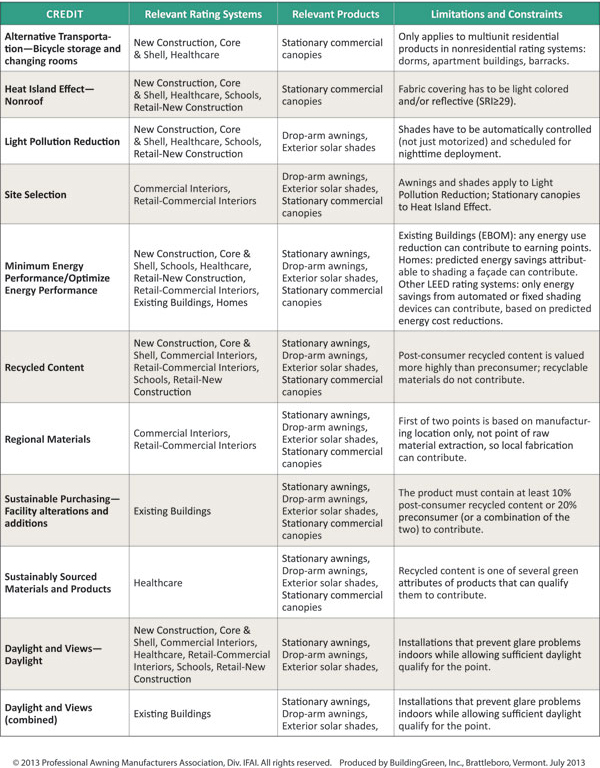
Used by permission from the Professional Awning Manufacturers Association (PAMA)
Unique fabric shade structures such as bike shelters and walkways could bring added LEED points. It's clear from the competitions discussed here that the intersection of architect imaginations and shading fabrics could produce some unexpected designs in the future.
Conclusion
In the perfect storm of a rapidly heating planet, southern population migrations, green building trends, and out-of-the-box innovations by emerging architects, the use of fabric for shading structures and strategies is sure to escalate in coming decades. These innovative structures bring a number of benefits: appealing design, functionality, UV protection, health benefits, and positive impact on performance and energy efficiency.
“Connecting to the natural environment is a growing trend,” Kushner notes. “People want it, and the design community is responding by trying to sew our buildings back into the natural environment. And shade is the in-between. Shade is the in-between concerning outside and inside. And the more that we can occupy that zone, the more we give people what they want.”
“I hope architects find new ways to create shade that's beautiful, flexible, and environmentally responsible,” notes Bernstein. “Beauty and functionality are both important.”
ENDNOTES
1. http://goo.gl/3dJy3; http://goo.gl/IG203c
4. http://www.med.upenn.edu/poolcool/managers.shtml
7. http://www.awninginfo.com/downloads/2013/PAMA LEED fact sheet July2013.pdf
8. http://specialtyfabricsreview.com/articles/0314_sw3_artbasel_twist.html
 |
Introduced in 1961, the Sunbrella® brand revolutionized the way the world thinks about how beautiful fabrics look, feel, and perform. Sunbrella fabrics are the leading premium choice for awning, marine, and furniture manufacturers, offering legendary durability, fade resistance, and ease of cleaning. Sunbrella fabrics are designed, manufactured, and marketed by Glen Raven, a 134-year-old family-owned company based in North Carolina with operations worldwide. For more information on the Sunbrella brand, including fabric resources, visit www.sunbrella.com. |

